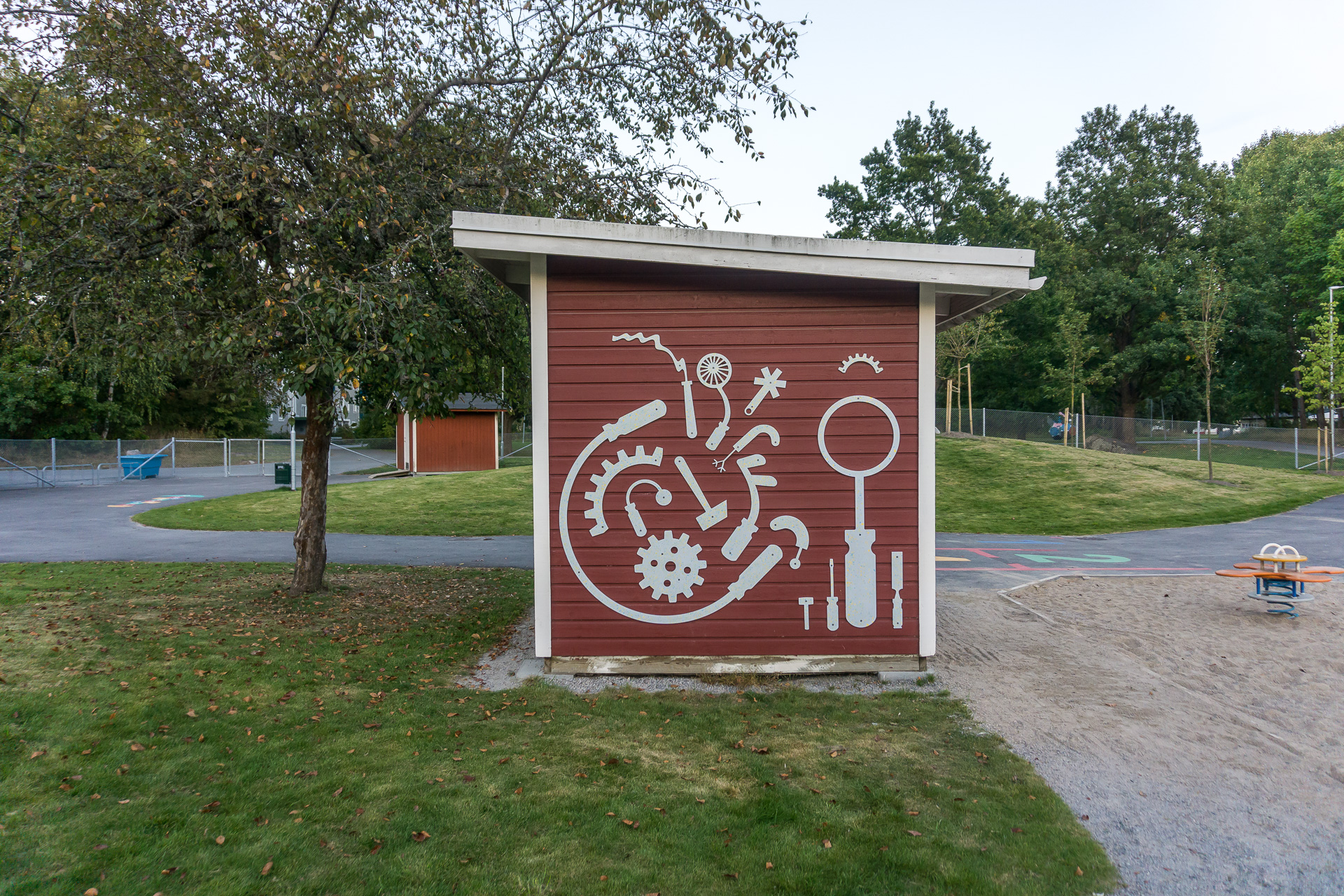Prylar, grejer, mojänger och grunkor (Thingamajigs, Gadgets, Doodads and Stuff)
På ena långsidan av en röd träbyggnad, stor som en redskapsbod eller busskur, har ett antal figurer hängts upp. Figurerna är vita och ligger platta som pappersdockor mot väggen. De är alla konturer av olika föremål. Vid en första anblick förefaller figurerna som mycket konkreta och föreställande avbildningar. Vi tycker oss tex urskilja ett hopprep, olika verktyg och annat som vi känner igen. Men tittar vi lite mera noga så ser vi att någon liten detalj hos varje figur ofta avviker från det välkända.

What does a doodad look like? And what are the thingamajigs that artist Kristina Lindberg has hung up on the preschool shed? This is what the artist herself says about her work:
The work can be compared to a shape puzzle for small children, where the goal is to put the right shape into the right hole. But with the big exception that there is no right or wrong here. Rather, the focus is on discovering new shapes in the work when you look at it or touch it, and on finding a language or a word for expressing what you see.
The objects or tools represented in the shapes are pure figments of the imagination and it is the viewer who has to decide whether they are looking at kitchen utensils, tools, magical instruments, etc. The work is thus extended and completed in the viewer’s gaze.
As a visual artist, Lindgren is interested in colour and shape. The artwork was created based on the conviction that children also think colour and shape are exciting.
What is shape and does everything have a shape? How do we describe the shape of an object? Discussing what words such as pointy, round, square or flat mean, or what curves, symmetries or spirals entail, help us to create tools to describe the world around us. We can use shapes to recognize objects, which is an important skill to learn and master.
On another level, the artwork connects to the history of its installation site. The flakes in the paint and the tool-like shapes are intended to make adult viewers think of the record years for industrialism during the 1950s when the Baronbackarna apartment buildings and Lars Wivallius preschool were built. The area was considered a model for residential planning and came to influence apartment building construction throughout Sweden.
Kristina Lindberg was born in 1981 and began her artistic education at Örebro Art College in 2005 before going on to the Gerrit Rietveld Academie in Amsterdam and Valand in Gothenburg. She has been exhibiting in Sweden and internationally since her studies.
Konstverk: Prylar, grejer, mojänger och grunkor (Thingamajigs, Gadgets, Doodads and Stuff)
Konstnär: Kristina Lindberg
År: 2016
Material: Painted stainless steel
Placering: Lars Wivallius preschool
Ägare: Örebro Municipality
Konstverkets position på karta
Publicerad:
Tack för ditt svar!
Berätta gärna vad vi kan göra bättre på den här sidan för att förbättra webbplatsen! Vi har ingen möjlighet att svara, men dina synpunkter är värdefulla för oss. Tänk på att inte skicka in personuppgifter. Om du vill ha svar på en fråga kan du istället använda formuläret ”Lämna en synpunkt”.
Om du ändå skickar in personuppgifter via detta formulär hanteras uppgifterna av Kommunstyrelsen och kan eventuellt lämnas vidare till annan verksamhet inom Örebro kommun i syfte att förbättra vår service.
Här hittar du mer information om hur vi hanterar personuppgifter.
Tack för ditt svar!
Du har nu hjälpt oss att förbättra orebro.se
